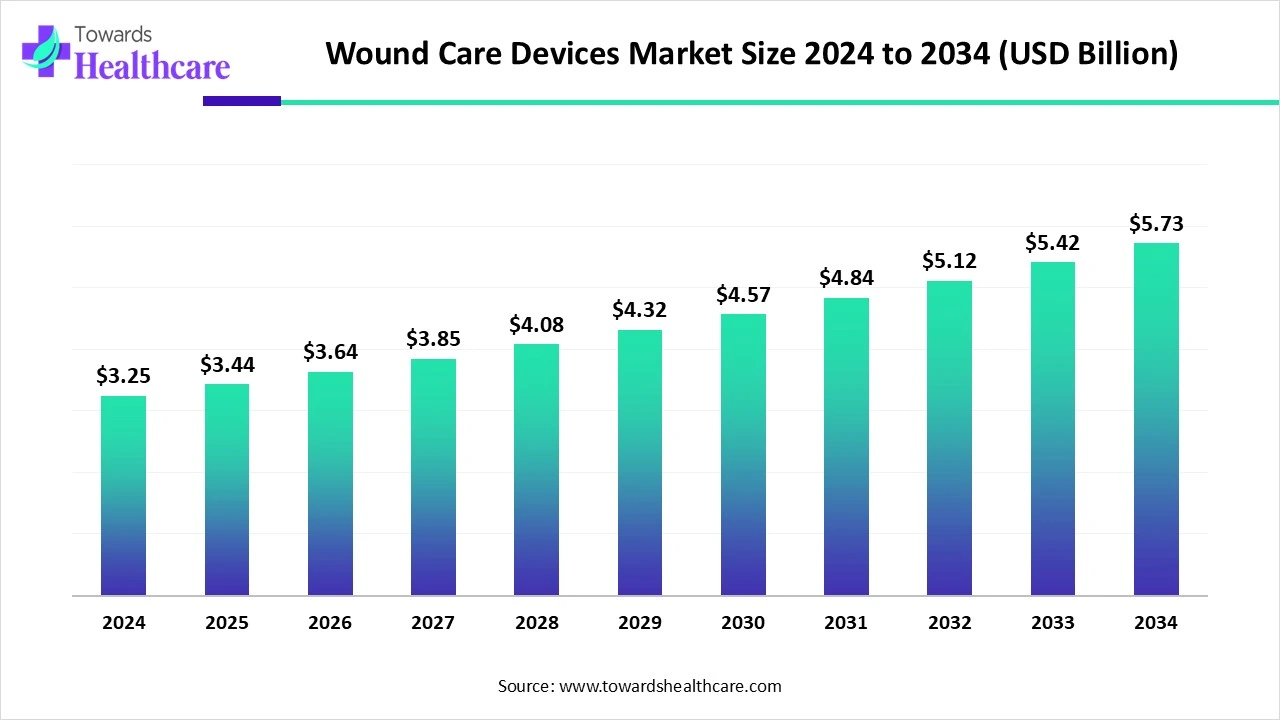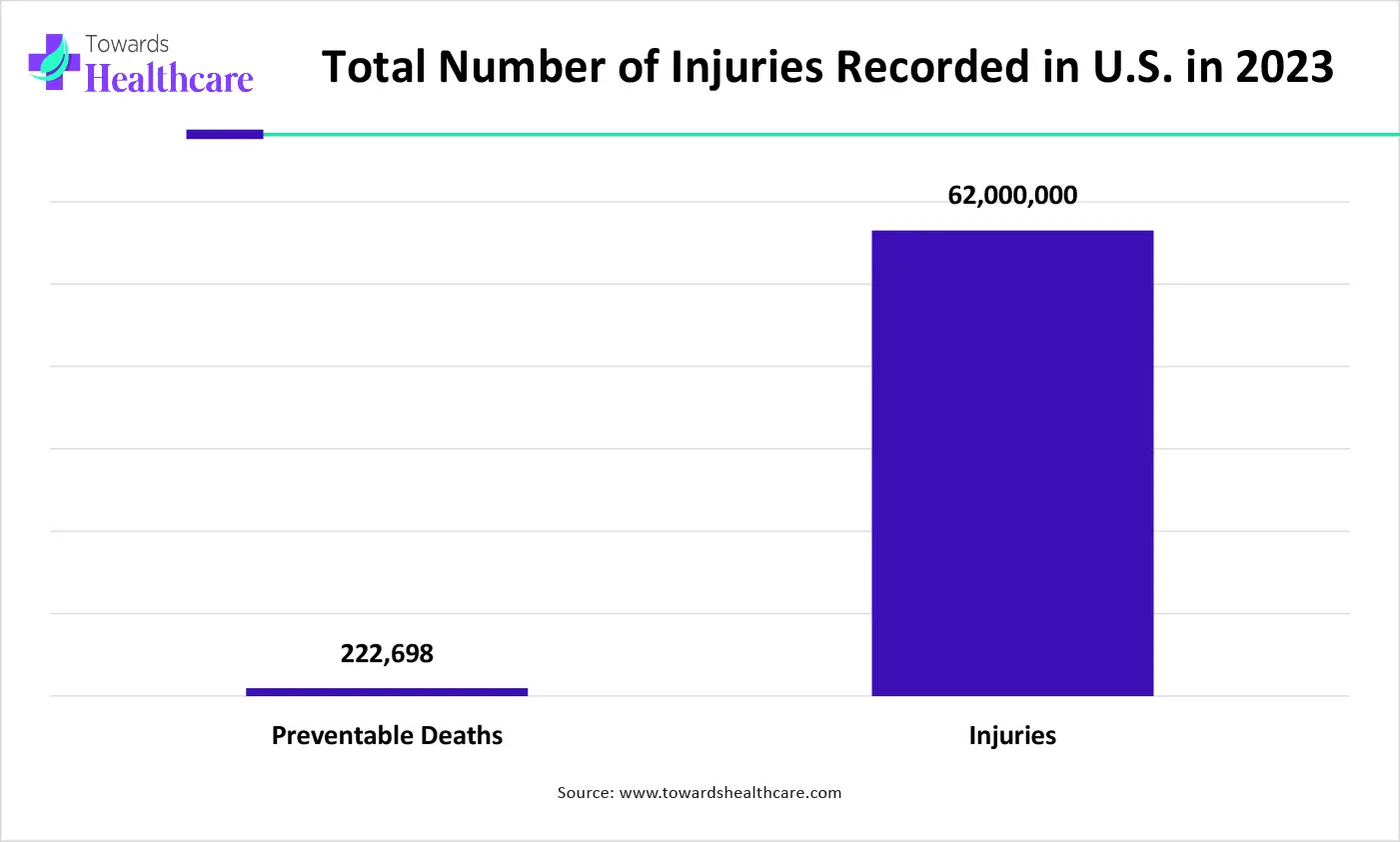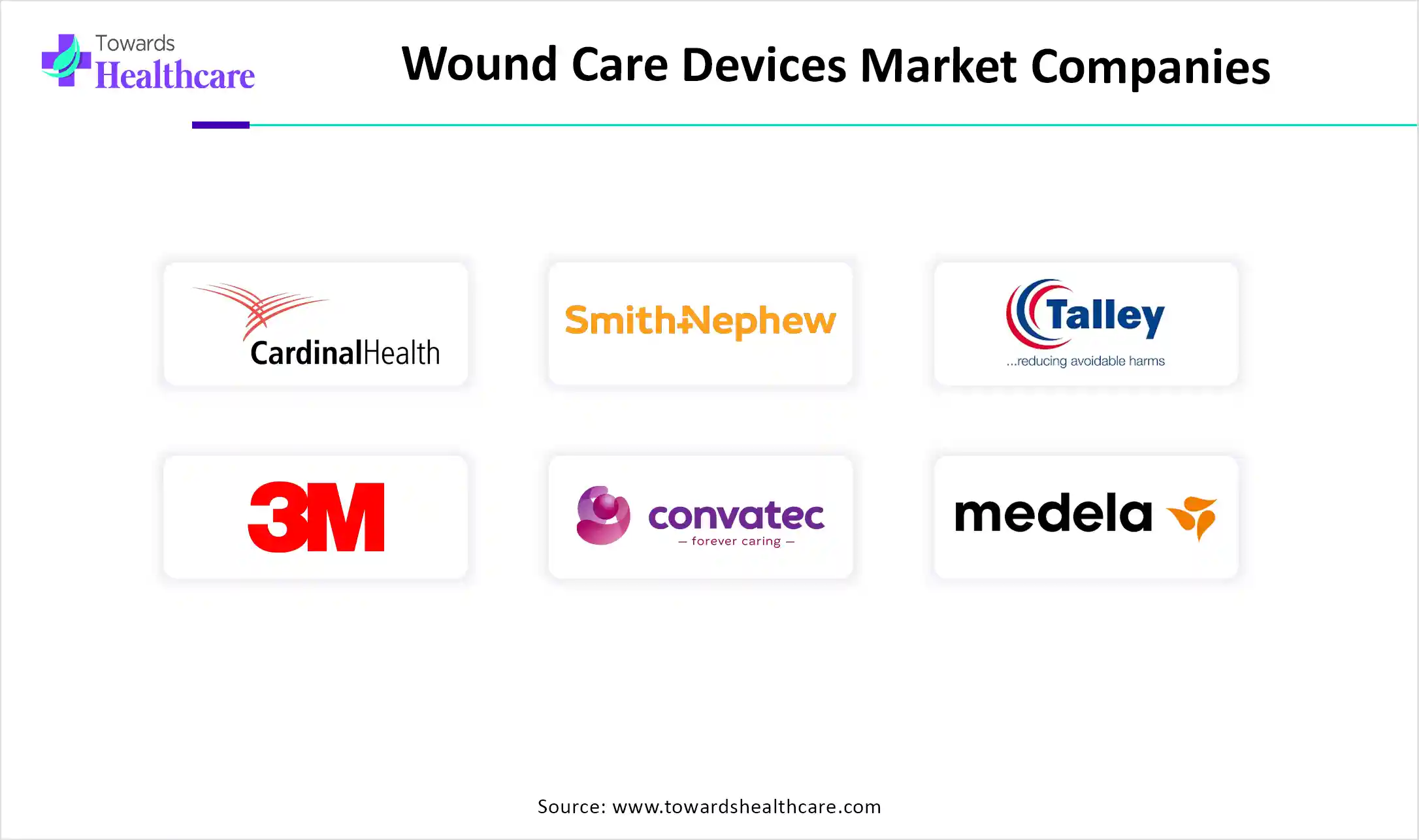November 2025

The global wound care devices market size is calculated at USD 3.25 in 2024, grew to USD 3.44 billion in 2025, and is projected to reach around USD 5.73 billion by 2034. The market is expanding at a CAGR of 5.84% between 2025 and 2034.

| Metric | Details |
| Market Size in 2025 | USD 3.44 Billion |
| Projected Market Size in 2034 | USD 5.73 Billion |
| CAGR (2025 - 2034) | 5.84% |
| Leading Region | North America |
| Market Segmentation | By Product Type, By Indication, By End User, By Region |
| Top Key Players | Cardinal Health, Smith & Nephew, Talley Group Ltd, 3M, Conva Tec Inc., Devon Medical Products, Medela AG, DeRoyal Industries, Inc., BSN medical, Others |
Wound healing involves a complex process, which is important for restoring the function of the skin barrier. Hence, the treatment of chronic wounds is considered an unmet need in the medical field. Therefore, to deal with such a condition, a variety of medical devices are being developed. The different types of medical devices include wearable wound monitors, surgical sutures, negative pressure wound therapy devices, and wound dressings. These can be used to improve the chronic wound environment as well as skin tissue regeneration. These products may consist of natural or synthetic polymers or bioactive molecules.
The wound, as well as the injuries due to the chemical, physical, and pathological factors, can also be life-threatening because of the microbial infections. Thus, integrating the wound care devices with the AI technology can effectively provide analysis and processing of the image information related to the wounds or injuries. The wound care and research are also being enhanced by utilizing AI-based methods as well as algorithms such as neural networks, deep learning, and machine learning. These further provide wound treatment, rehabilitation, diagnosis, and prognosis decision support.
Increasing Chronic Wounds
The incidence of chronic wounds is rising, which take a long time to heal completely. These wounds can be associated with different diseases, such as diabetes, pressure ulcers, etc. If these wounds are not treated properly, then they may become severe due to infection, which may lead to amputations or even death. Thus, this increases the demand for the use of wound care devices within the population. These devices help to improve the wounds, resulting in faster healing. Thus, all these factors contribute to the wound care devices market growth.

The graph represents the total number of injuries recorded in the U.S. in the year of 2023. It indicates that there is a rise in the number of injuries, which in turn, causes a rise in the wounds. Hence, it increases the demand for wound care devices for the effective management of these injuries or wounds. Thus, this in turn will ultimately promote the market growth. (Source - INJURY FACTS)
High Prices
The wound care devices consist of high prices due to which prevents various patients as well as hospitals are unable to using them. This, in turn, increases the use of alternatives to the devices, restricting their use. At the same time, due to the late reimbursements of the policies reduce their adoption is reduced during the treatment of the wounds. Thus, all these factors decrease the use, which causes them to shift towards affordable treatment practices.
How Chronic Wounds are Promoting the Wound Care Devices Market?
The increasing chronic wounds within the patient associated with different diseases is increasing the demand for the use of wound care devices for their treatment. Similarly, these wounds are not healed properly by using conventional dressing methods. Therefore, the adoption of wound care devices increases. Moreover, it also amplifies the healing process, enhancing patient satisfaction. The advancement in these devices is also contributing to the same. Thus, all these factors promote the wound care devices market growth.
For instance,
By product type, the negative pressure wound therapy (NPWT) segment dominated the market in 2024. This segment dominated because the NPWT provided a faster healing process as well and was used in various wound treatments associated with different diseases. This contributed to the wound care devices market growth.
By product type, the hyperbaric oxygen therapy (HOT) segment is estimated to grow significantly at a notable CAGR during the forecast period. The use of hyperbaric oxygen therapy is increasing due to the increasing chronic wounds. They are accelerating the healing process of these wounds.
By indication type, the diabetic ulcer segment dominated the market in 2024. This is due to the rising prevalence of diabetes and the growing geriatric population. The diabetic ulcer caused an increased adoption of wound care devices due to its effective treatment of the chronic condition, as well as complications caused by microbial infections.
By indication type, the pressure ulcer segment is anticipated to grow significantly during the forecast period. The incidence of pressure ulcers in the geriatric population is growing. This, in turn, raises the demand for the treatment of ulcers using wound care devices.
By end user, the hospital segment dominated the global wound care devices market in 2024. This segment dominated as the hospitals consisted of various large volumes of patients associated with wounds. Thus, it provided effective treatment of the wound using devices along with skilled personnel and advanced technologies.
By end user, the homecare settings segment is predicted to be the fastest growing during the forecast period. The homecare settings provide comfort as well as minimize hospital visits. Furthermore, the use of wound care devices can also help to monitor the treatment, enhancing its effectiveness and patient satisfaction.
North America dominated the wound care devices market in 2024. North America consisted of well-established research and development sectors, along with technological advancements and skilled personnel. Furthermore, the government and regulatory support contributed to the market growth.
For instance,
The research and development sectors in the industries are well-developed in the U.S. They also consist of advanced technologies that help in manufacturing, as well as skilled personnel. At the same time, the research on wound care devices in the institutes is also rising, which is funded by the government.
Canada consists of advanced industries and institutes with well-equipped R&D sectors. This, in turn, increases the research as well as the collaboration. Moreover, the regulatory bodies and the government also support this production process.
Asia Pacific is estimated to host the fastest-growing wound care devices market during the forecast period. Asia Pacific is experiencing a growth in the population, which causes an increase in the disease burden, leading to disease-associated wounds. Thus, the demand for wound care devices rises, enhancing the market growth.
China consists of a large volume of population, which also increases the wound incidence. It also has well-developed healthcare systems, which are adapting to various technological advancements. This, in turn, increases the production as well as the use of wound care devices.
Rising incidences of diseases are increasing the wounds associated with them, increasing the demand for effective wound healing treatments. Thus, the healthcare systems, along with government support, are utilizing the use of wound care devices at affordable prices.
Europe is expected to grow significantly in the wound care devices market during the forecast period. The healthcare sector in Europe is adapting to various technological advancements. At the same time, various policies as well as guidelines are also enhancing the use of wound care devices, which promotes the market growth.
The healthcare systems in Germany are advancing due to the increasing use of advanced technologies in the treatment of wounds. Furthermore, industries are also developing new devices to improve the healing process as per the guidelines of the government.
The UK healthcare sector is focusing on the development of new wound care devices, which is increasing the collaboration within the companies. At the same time, to enhance the safety while using these devices, various guidelines and polices are also implemented, which increases the satisfaction among the patients.
Latin America is expected to grow at a notable CAGR in the wound care devices market in the foreseeable future. The rising prevalence of chronic wounds and the rapidly expanding medical device sector boost the market. The growing demand for rehabilitation and advancements in technologies propel market growth. Government organizations support the development and distribution of innovative wound care devices through funding. The increasing collaborations among key players also lead to the latest innovations in the field.
The International Diabetes Federation (IDF) reported that 85,855,300 people were living with diabetes in 2024. (Source: IDF) In February 2024, the GSU Mexico Hub organized a community engagement event on wound care and infection prevention. (Source: GSU Mexico) Such events create awareness of wound care devices and increase their use.
Approximately 155,426,300 people were estimated to have diabetes in Brazil in 2024. (Source: IDF) The Brazilian government actively supports the indigenous development of medical devices. Brazil hosts the “4th Global Conference on Advanced Wound Care and Wound Management” in June 2025 to foster collaboration and spark progress that reshapes the future of wound care. (Source: Pulsus)

By Product Type
By Indication
By End User
By Region
November 2025
October 2025
October 2025
November 2025